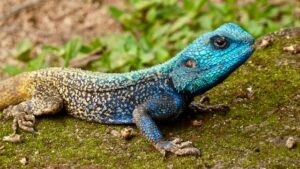
The Evolutionary History of Reptiles: From Dinosaurs to Modern-Day Species
Contents
- 1 Introduction
- 2 What are Reptiles?
- 3 Reptile Classification
- 4 What is the Difference Between Reptiles and Amphibians?
- 5 How Do Turtles Fit into the Reptile Family Tree?
- 6 How Did Birds Evolve From Dinosaurs?
- 7 The Evolution of Modern Reptiles
- 8 Learn about how reptiles evolved from ancient dinosaurs.
- 9 Conclusion
Introduction
Reptiles are a diverse group of animals that have existed for millions of years. In fact, reptiles were the dominant vertebrates on Earth during the Mesozoic era, or the “Age of Reptiles.” Over time, however, mammals became the dominant class of animals on land and in the ocean. Though there are still plenty of modern-day reptiles roaming around our planet today—including snakes, lizards and turtles—there are also many species that have died off since their heyday millions of years ago. In this article we’ll take an evolutionary journey through time to learn more about how these prehistoric creatures evolved into modern-day species!
What are Reptiles?
Reptiles are cold-blooded animals that have scales, lay eggs, and reproduce through internal fertilization. Reptiles can be found on every continent except Antarctica–and they come in all shapes and sizes!
There are over 6500 species of reptiles in the world today. This includes snakes (like cobras), lizards (such as iguanas), turtles and tortoises (including box turtles). The name “reptile” comes from the Latin word “reptus”, meaning ‘creep’.
Reptile Classification
Reptiles are cold-blooded and ectothermic. They lay eggs, which they protect with a hard shell. Reptiles live on land or in water and have scales and dry skin. They also have a backbone, which allows them to move by walking.
Many species of reptiles are closely related to dinosaurs; however, not all dinosaurs were reptilian (e.g., birds). Dinosaurs evolved into modern-day birds over time as they changed their body structure from having four legs to two wings that allow them to fly through the air at high speeds!
What is the Difference Between Reptiles and Amphibians?
While both reptiles and amphibians are cold-blooded, there are some key differences. Reptiles lay eggs that must be incubated in order to hatch. Amphibians, on the other hand, give birth to live young that are not fully developed when they emerge from their mother’s body.
In addition to these differences in reproduction strategies and life cycles, reptiles have scales while amphibians have skin with mucus glands (to keep them moist).
How Do Turtles Fit into the Reptile Family Tree?
Turtles are reptiles. They have scales, live on land and breathe air. But that’s where their similarities with other reptiles end.
Turtles don’t have any bones in their necks, so they can’t move their heads very well. But they do have a shell made of bone that protects them from predators when they hide under bushes or logs on land because they can’t swim very well either (although some sea turtles can).
Turtles also lack teeth and claws–they prefer to eat fruits and vegetables rather than meat like other carnivores (meat-eaters). They lay eggs instead of giving birth to live young ones like mammals do; this means that baby turtles hatch from eggs instead of being born directly from their mothers’ bodies like most other animals do!
How Did Birds Evolve From Dinosaurs?
Birds are a group of animals that evolved from small, feathered dinosaurs. Birds have many features in common with reptiles, but they’re not reptiles–they’re warm-blooded and lay eggs instead of giving birth to live young.
There are three main groups of living birds: modern birds (that is, those that exist today), extinct birds (those which went extinct before humans came along), and close relatives of modern birds called “avians”. The latter two groups have been around since before the extinction event at the end of the Cretaceous Period 65 million years ago
The Evolution of Modern Reptiles
There are many different types of reptiles, but they all share certain characteristics. Reptiles are vertebrates, which means they have a backbone. They are cold-blooded and ectothermic; that is, their body temperature varies with the environment around them. In addition to having scales or scutes (the hard plates covering their skin), most species have legs that allow them to move quickly on land or through water.
Learn about how reptiles evolved from ancient dinosaurs.
The first reptiles appeared around 250 million years ago and have since diversified into over 10,000 species, including snakes, lizards and turtles.
Reptiles are ectothermic (cold-blooded) animals with scales covering their bodies for protection against predators or the elements. They lay eggs rather than give birth to live young like mammals do – this means that reptile eggs must be kept at an optimal temperature in order to develop properly so as not to get too hot or too cold during incubation; otherwise they may die out before hatching occurs! Reptiles also have a three-chambered heart instead of four chambers like humans do; this allows them greater flexibility when it comes time for movement across land surfaces where temperatures fluctuate widely throughout each day (think deserts).
Conclusion
Reptiles are a group of animals that have been on Earth for millions of years. The first reptiles evolved from amphibians and are believed to have first appeared around 250 million years ago. These early reptiles had long bodies with tails and legs, but their skulls were still similar in shape to those of fish or dinosaurs. Over time, these creatures’ bodies changed dramatically as they adapted to different environments around the world–from deserts where water was scarce (like today), to jungles where food was plentiful enough for them all year round without any need for hibernation! Today’s modern reptiles include turtles, lizards and snakes; some species even have special adaptations like warm bloodedness or cold bloodedness which allows them live anywhere on Earth except Antarctica (where there would be no food anyway).



Average Rating